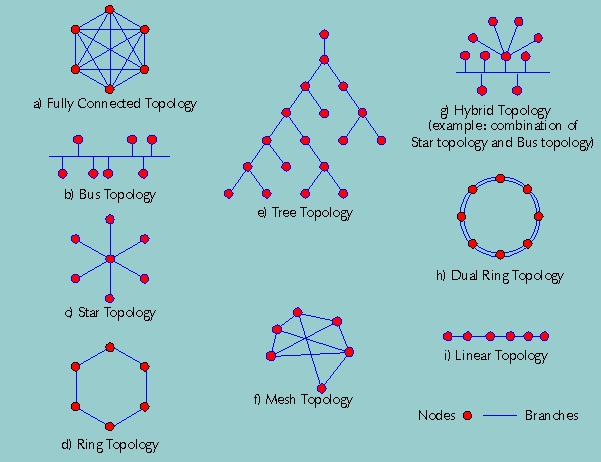network topology
The specific physical, i.e., real, or logical, i.e., virtual, arrangement of the elements of a network. Note 1: Two networks have the same topology if the connection configuration is the same, although the networks may differ in physical interconnections, distances between nodes, transmission rates, and/or signal types. Note 2: The common types of network topology are illustrated [refer to the figure on this page] and defined in alphabetical order below:
- bus topology: A network topology in which all nodes, i.e., stations, are connected together by a single bus.
- fully connected topology: A network topology in which there is a direct path (yybranch) between any two nodes. Note: In a fully connected network with n nodes, there are n(n-1)/2 direct paths, i.e., branches. Synonym fully connected mesh network.
- hybrid topology: A combination of any two or more network topologies. Note 1: Instances can occur where two basic network topologies, when connected together, can still retain the basic network character, and therefore not be a hybrid network. For example, a tree network connected to a tree network is still a tree network. Therefore, a hybrid network accrues only when two basic networks are connected and the resulting network topology fails to meet one of the basic topology definitions. For example, two star networks connected together exhibit hybrid network topologies. Note 2: A hybrid topology always accrues when two different basic network topologies are connected.
- linear topology: See bus topology.
- mesh topology: A network topology in which there are at least two nodes with two or more paths between them.
- ring topology: A network topology in which every node has exactly two branches connected to it.
- star topology: A network topology in which peripheral nodes are connected to a central node, which rebroadcasts all transmissions received from any peripheral node to all peripheral nodes on the network, including the originating node. Note 1: All peripheral nodes may thus communicate with all others by transmitting to, and receiving from, the central node only. Note 2: The failure of a transmission line, i.e., channel, linking any peripheral node to the central node will result in the isolation of that peripheral node from all others. Note 3: If the star central node is passive, the originating node must be able to tolerate the reception of an echo of its own transmission, delayed by the two-way transmission time, i.e., to and from the central node, plus any delay generated in the central node. An active star network has an active central node that usually has the means to prevent echo-related problems.
- tree topology: A network topology that, from a purely topologic viewpoint, resembles an interconnection of star networks in that individual peripheral nodes are required to transmit to and receive from one other node only, toward a central node, and are not required to act as repeaters or regenerators. Note 1: The function of the central node may be distributed. Note 2: As in the conventional star network, individual nodes may thus still be isolated from the network by a single-point failure of a transmission path to the node. Note 3: A single-point failure of a transmission path within a distributed node will result in partitioning two or more stations from the rest of the network.
